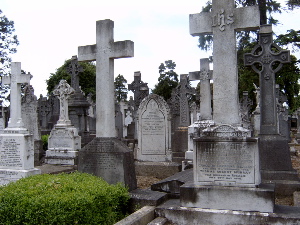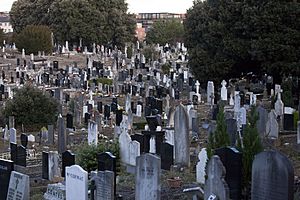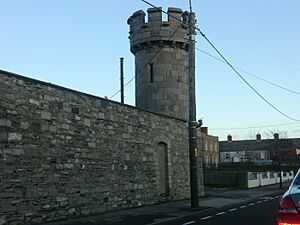Glasnevin Cemetery facts for kids
Glasnevin Cemetery (Irish: Reilig Ghlas Naíon) is a large and important cemetery in Glasnevin, Dublin, Ireland. It first opened its gates in 1832. This special place holds the graves and memorials of many famous Irish people. It also has a museum where you can learn about its history.
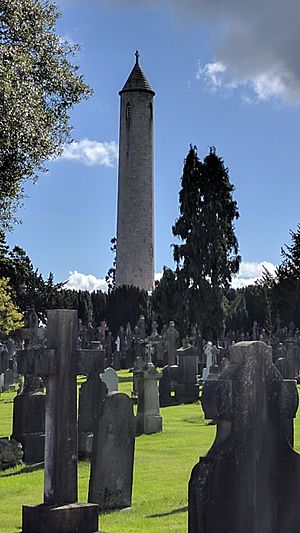
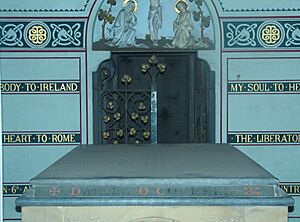
Contents
Where is Glasnevin Cemetery?
The cemetery is located in Glasnevin, Dublin. It is split into two main parts. The larger section, known for its tall walls and watchtowers, is on one side of the road. The other part, called "St. Paul's," is across the road.
You can also find a special entrance from the cemetery into the National Botanic Gardens. This gateway was reopened a few years ago.
A Look Back: The Story of Glasnevin Cemetery
Why Was it Needed?
Before Glasnevin Cemetery opened, Irish Catholics faced challenges in burying their loved ones. Laws from the 1700s made it difficult for them to hold their own funeral services in public. They often had to use Protestant churchyards.
In 1823, an event at a funeral caused a public outcry. A Protestant church official stopped a Catholic priest from performing a funeral service. This led Daniel O'Connell, a leader who fought for Catholic rights, to take action. He argued that there was no law against praying for a dead Catholic in a graveyard. O'Connell worked hard to create a burial ground where both Catholics and Protestants could bury their dead with respect.
Opening Its Gates
Glasnevin Cemetery was officially opened on February 21, 1832. The very first person buried there was Michael Carey, an eleven-year-old boy from Dublin. This happened the next day. The cemetery was first called Prospect Cemetery, named after the area around it.
Besides the famous people buried here, nearly 800,000 people were laid to rest in unmarked graves. Many of these were victims of the Great Famine in the 1840s and a later cholera outbreak.
Growing Over Time
When it first opened, the cemetery covered about nine acres. Today, it has grown to around 124 acres. This includes the "St. Paul's" section across the road. Since 1982, people have also had the option of cremation here.
Who Looks After the Cemetery?
The Dublin Cemeteries Committee is in charge of Glasnevin Cemetery. They work to maintain and improve the cemetery, making sure it continues to be a respectful place for burials.
Special Services
A Catholic Mass is held every Sunday morning at 9:45 AM by local priests. Each summer, there is an annual blessing of the graves. This tradition has continued since the cemetery first opened in 1832.
Important Features of the Cemetery
Famous Graves and Memorials
Glasnevin Cemetery is home to many important monuments and the graves of some of Ireland's most famous people. These include leaders like Daniel O'Connell, Charles Stewart Parnell, Michael Collins, and Éamon de Valera. You can also find the graves of writers like Brendan Behan and musicians like Luke Kelly of the Dubliners.
The grave of Michael Collins is one of the most visited spots. He was an important Irish leader who died in 1922. Around his grave, there is a memorial listing the names of 183 soldiers who also died.
In 1993, a mass grave was found at the site of a former institution where women lived and worked. The remains were later cremated and reburied in a mass grave at Glasnevin Cemetery.
The cemetery also shows how burial monuments have changed over the last 200 years. You can see simple stone markers from the early days, detailed Celtic crosses from a time of Irish pride, and plain marble stones from more recent times.
The tall walls and watchtowers around the main part of the cemetery were built for a special reason. In the 1700s and early 1800s, there were people called bodysnatchers in Dublin. They would dig up bodies from graves. The watchmen at Glasnevin even had bloodhounds to help guard the cemetery at night!
Since 2009, Glasnevin Trust has worked with the Commonwealth War Graves Commission (CWGC). They have identified the graves of Irish service members who died in the two world wars while serving with Commonwealth forces. Their names are now on two memorials near the main entrance. A special Cross of Sacrifice was also put up in 2011 to remember those who died in the First World War. As of 2019, 215 service members from both wars are buried here.
The Angels Plot
Glasnevin is one of the few cemeteries that has a special area called the Angels Plot. This section is set aside for the burial of stillborn babies.
Crematorium Services
In 1982, a crematorium was built within the cemetery grounds. It offers cremation services for people of different religious backgrounds.
Museum and Tours
The Glasnevin Trust Museum opened in 2010. It was designed by A&D Wejchert & Partners Architects and includes a café.
The cemetery also offers guided tours. They welcome educational groups and provide help for people researching their family history.
See also
 In Spanish: Cementerio de Glasnevin para niños
In Spanish: Cementerio de Glasnevin para niños
- Burials in Glasnevin Cemetery


